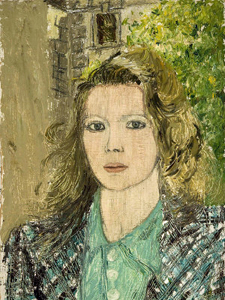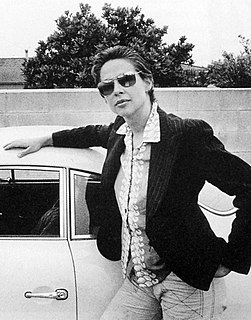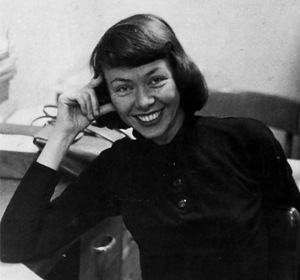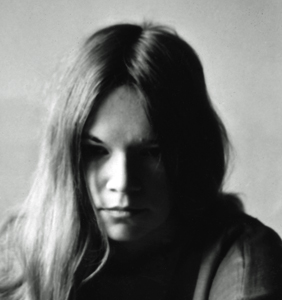
Lorraine O'Grady is an American artist, writer, translator, and critic. Working in conceptual art and performance art that integrates photo and video installation, she explores the cultural construction of identity – particularly that of Black female subjectivity – as shaped by the experience of diaspora and hybridity. O'Grady studied at Wellesley College and the University of Iowa Writers' Workshop before becoming an artist at age forty-five. Regarding the purpose of art, O'Grady said in 2016: "I think art’s first goal is to remind us that we are human, whatever that is. I suppose the politics in my art could be to remind us that we are all human."

Wangechi Mutu is a Kenyan-born American visual artist, known primarily for her painting, sculpture, film, and performance work. Born in Kenya, she has lived and established her career in New York for more than twenty years. Mutu's work has directed the female body as subject through collage painting, immersive installation, and live and video performance all the while exploring questions of self-image, gender constructs, cultural trauma, and environmental destruction, as well as notions of beauty and power.

Linda Nochlin was an American art historian, Lila Acheson Wallace Professor Emerita of Modern Art at New York University Institute of Fine Arts, and writer. As a prominent feminist art historian, she became well known for her pioneering 1971 article "Why Have There Been No Great Women Artists?" published by ARTnews.

The feminist art movement in the United States began in the early 1970s and sought to promote the study, creation, understanding and promotion of women's art. First-generation feminist artists include Judy Chicago, Miriam Schapiro, Suzanne Lacy, Judith Bernstein, Sheila de Bretteville, Mary Beth Edelson, Carolee Schneeman, Rachel Rosenthal, and many other women. They were part of the Feminist art movement in the United States in the early 1970s to develop feminist writing and art. The movement spread quickly through museum protests in both New York and Los Angeles, via an early network called W.E.B. that disseminated news of feminist art activities from 1971 to 1973 in a nationally circulated newsletter, and at conferences such as the West Coast Women's Artists Conference held at California Institute of the Arts and the Conference of Women in the Visual Arts, at the Corcoran School of Art in Washington, D.C..

Sylvia Sleigh was a Welsh-born naturalised American realist painter who lived and worked in New York City. She is known for her role in the feminist art movement and especially for reversing traditional gender roles in her paintings of nude men, often using conventional female poses from historical paintings by male artists like Diego Vélazquez, Titian, and Jean-Auguste-Dominique Ingres. Her most well-known subjects were art critics, feminist artists, and her husband, Lawrence Alloway.
The Elizabeth A. Sackler Center for Feminist Art is located on the fourth floor of the Brooklyn Museum, New York City, United States.

Lynda Benglis is an American sculptor and visual artist known especially for her wax paintings and poured latex sculptures. She maintains residences in New York City, Santa Fe, New Mexico, Kastellorizo, Greece, and Ahmedabad, India.

May Stevens was an American feminist artist, political activist, educator, and writer.

Howardena Pindell is an American artist, curator, and educator. She is known as a painter and mixed media artist, her work explores texture, color, structures, and the process of making art; it is often political, addressing the intersecting issues of racism, feminism, violence, slavery, and exploitation. She is known for the wide variety of techniques and materials used in her artwork; she has created abstract paintings, collages, "video drawings," and "process art."
Anita Slavin Arkin Steckel was an American feminist artist known for paintings and photomontages with sexual imagery. She was also the founder of the arts organization "The Fight Censorship Group", whose other members included Hannah Wilke, Louise Bourgeois, Judith Bernstein, Martha Edelheit, Eunice Golden, Juanita McNeely, Barbara Nessim, Anne Sharpe and Joan Semmel.
"Where We At" Black Women Artists, Inc. (WWA) was a collective of Black women artists affiliated with the Black Arts Movement of the 1960s and 1970s. It included artists such as Dindga McCannon, Kay Brown, Faith Ringgold, Carol Blank, Jerri Crooks, Charlotte Kâ (Richardson), and Gylbert Coker. Where We At was formed in the spring of 1971, in the wake of an exhibition of the same name organized by 14 Black women artists at the Acts of Art Gallery in Greenwich Village. Themes such as the unity of the Black family, Black female independence and embodiment, Black male-female relationships, contemporary social conditions, and African traditions were central to the work of the WWA artists. The group was intended to serve as a source of empowerment for African-American women, providing a means for them to control their self-representation and to explore issues of Black women's sensibility and aesthetics. Like AfriCobra, a Chicago-based Black Arts group, the WWA was active in fostering art within the African-American community and using it as a tool of awareness and liberation. The group organized workshops in schools, jails and prisons, hospitals, and cultural centers, as well as art classes for youth in their communities.
The feminist art movement refers to the efforts and accomplishments of feminists internationally to produce art that reflects women's lives and experiences, as well as to change the foundation for the production and perception of contemporary art. It also sought to bring more visibility to women within art history and art practice. By the way it is expressed to visualize the inner thoughts and objectives of the feminist movement to show to everyone and give meaning in the art. It helps construct the role to those who continue to undermine the mainstream narrative of the art world. Corresponding with general developments within feminism, and often including such self-organizing tactics as the consciousness-raising group, the movement began in the 1960s and flourished throughout the 1970s as an outgrowth of the so-called second wave of feminism. It has been called "the most influential international movement of any during the postwar period."
Mary Beth Edelson was an American artist and pioneer of the feminist art movement, deemed one of the notable "first-generation feminist artists." Edelson was a printmaker, book artist, collage artist, painter, photographer, performance artist, and author. Her works have been shown at the Museum of Modern Art, the Smithsonian American Art Museum, and the Museum of Contemporary Art in Chicago.
Cindy Heller Nemser was an American art historian and writer. Founder and editor of the Feminist Art Journal, she was an activist and prominent figure in the feminist art movement and was best known for her writing on the work of women artists such as Eva Hesse, Alice Neel, and Louise Nevelson.
This is a timeline of the feminist art movement in New Zealand. It lists important figures, collectives, publications, exhibitions and moments that have contributed to discussion and development of the movement. For the indigenous Māori population, the emergence of the feminist art movement broadly coincided with the emergence of Māori Renaissance.
Eunice Golden is an American feminist painter from New York City, known for exploring sexuality using the male nude. Her work has been shown at the Whitney Museum of American Art, Brooklyn Museum, Bronx Museum of the Arts, Westbeth Gallery, and SOHO20 Gallery.
June Druiett Blum was a multimedia American artist who produced paintings, sculptures, prints, light shows, happenings, jewelry, art books, pottery, conceptual documentations, and drawings. She was also a feminist curator and activist who worked to advance the women's movement and increase visibility for women artists.

Rosemary Mayer (1943–2014), was an American visual artist who was closely associated with the feminist art movement and the conceptual art movement of the 1970s. She was a founding member of A.I.R. gallery, the first all-female artists cooperative gallery in the United States.
Global Feminisms was a feminist art exhibition that originally premiered at the Elizabeth A. Sackler Center for Feminist Art at the Brooklyn Museum, New York City, United States, in March 2007. Global Feminisms was the first international exhibition exclusively dedicated to feminist art from 1990 to present. The exhibition was co-curated by Maura Reilly and Linda Nochlin and consists of work by 88 women artists from 62 countries. Global Feminisms showcased work in all media forms, including painting, sculpture, photography, film, video, installation, and performance, with a focus on contemporary feminist art from a global perspective. Conceived as a counterpoint to the landmark 1976 exhibition Women Artists: 1850-1950, the curators aimed to move beyond a Western exclusionary feminism, which has dominated understandings of feminism and feminist art since the 1970s, towards one that is less-defined by a western center and "other" peripheries.

Brenda Patricia Agard was a Black-British photographer, artist, poet and storyteller who was most active in the 1980s, when she participated in some of the first art exhibitions organized by Black-British artists in the United Kingdom. Agard's work focused on creating "affirming images centred on the resilience of the Black woman," according to art historian Eddie Chambers.














